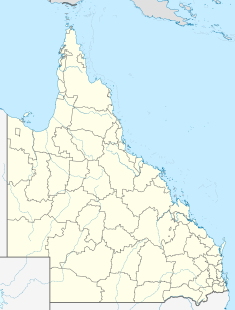Hibernian Hall, Roma
| Hibernian Hall, Roma | |
|---|---|

Hibernian Hall, 2010
|
|
| Location | 38-44 Hawthorne Street, Roma, Maranoa Region, Queensland, Australia |
| Coordinates | 26°34′21″S 148°47′19″E / 26.5726°S 148.7885°ECoordinates: 26°34′21″S 148°47′19″E / 26.5726°S 148.7885°E |
| Design period | 1919 - 1930s (interwar period) |
| Built | 1931 - 1932 |
| Architect | Cavanagh & Cavanagh |
| Official name: Hibernian Hall, HACBS Hall | |
| Type | state heritage (built) |
| Designated | 27 April 2001 |
| Reference no. | 601689 |
| Significant period | 1931-1932 (fabric) 1932-1976 (historical) 1932-ongoing (social) |
| Significant components | stage/sound shell, proscenium arch, ticket box/office, foyer - entrance, dance floor, projection booth/bio box, dining room, canteen, auditorium |
| Builders | George Power Williams |
Hibernian Hall is a heritage-listed community hall at 38-44 Hawthorne Street, Roma, Maranoa Region, Queensland, Australia. It was designed by Cavanagh & Cavanagh and built from 1931 to 1932 by George Power Williams. It is also known as HACBS Hall. It was added to the Queensland Heritage Register on 27 April 2001.
The Hibernian Hall in Roma is a large, timber-framed hall-cum-picture theatre erected in 1932 for the Roma branch of the Hibernian Australasian Catholic Benefit Society. It was designed by Perth and Brisbane architects Cavanagh & Cavanagh.
Roma was the principal town of the Mount Abundance district, which was developed as a pastoral and agricultural region following exploration by Thomas Mitchell, Surveyor General of New South Wales in 1846. The township of Roma was proclaimed in September 1862, one of the earliest towns established in Queensland after separation from New South Wales in 1859, and was surveyed in 1863. It was named after Lady Bowen (the Countess Diamantina Georgina di Roma), daughter of a Governor of the Ionian Islands, and wife of the first Governor of Queensland, Sir George Ferguson Bowen. The town of Roma was declared a municipality in 1867 and grew slowly as a pastoral service centre and government administrative centre until the opening of the Western railway line in the 1880s, connecting the Maranoa to the coastal ports, after which the town flourished. In addition, the vast Great Artesian Basin was tapped in the late 1880s and early 1890s, securing an alternative water supply for cattle and sheep.
...
Wikipedia


